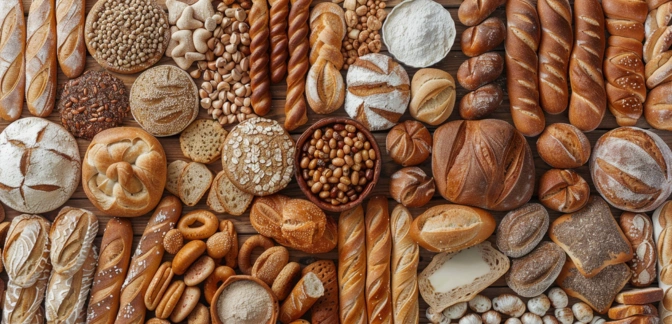Bread — Nutrients, Health Benefits, And Shopping Tips

Written by Listonic Team
Last update on September 4, 2024
Nutrients
Nutrition facts
Amount per 100 g
Calories
🔥 265 kcal
| Nutrition per: 100 g | Value | % Daily Value* |
|---|---|---|
| Carbs | 49 g | 17.82% |
| Fiber | 3 g | 10.71% |
| Sugars | 5 g | 10% |
| Glycemic Index | 75 | - |
| Protein | 9 g | 18% |
| Sodium | 491 mg | 21.35% |
| Total Fat | 3 g | 3.85% |
*The % of Daily Value (DV) tells you how much a nutrient in a serving of food contributes to a daily diet. 2,000 calories a day is used for general nutrition advice.
3 g
🥕 Low Fat Content
5 g
🍏 Low Sugar Content
Key takeaways
Health benefits
- Provides sustained energy from its complex carbohydrate content, making it a good source of fuel for the body and brain.
- Can be a source of fiber if made with whole grains, supporting digestive health and promoting regular bowel movements.
- Contains essential vitamins and minerals such as B vitamins, iron, and magnesium, which support overall health and well-being.
- Versatile and nutritious, serving as a base for a variety of healthy toppings and fillings.
Health risks
- High carbohydrate content which can cause rapid spikes in blood sugar levels, particularly concerning for diabetics or those on low-carb diets.
- Low nutrient density particularly in white bread made from refined flour, which lacks essential nutrients and fiber compared to whole grain options.
- Potential for overconsumption leading to excessive calorie intake and weight gain, especially when paired with high-calorie spreads or fillings.
- Gluten content which makes it unsuitable for individuals with celiac disease or gluten sensitivity, potentially causing digestive discomfort and other health issues.
How to choose bread
Bread should have a crisp crust and a soft, airy interior, ideally made from whole grains with few added sugars or preservatives. The aroma should be fresh and yeasty, a hallmark of proper fermentation practices.
Reject bread that feels excessively heavy or has a uniform, spongy texture, often a sign of overprocessing. Also, avoid bread with any signs of mold or an unusual smell, indicating it is past its best.

How to store bread
Bread should be stored at room temperature in a bread box or a paper bag to maintain its crust. Plastic bags can be used if you prefer a softer crust. Bread typically lasts up to a week when stored properly.
Refrigeration can make bread stale more quickly, so it’s best to avoid this. Humidity can cause mold growth, so storing bread in a dry place is essential. For longer storage, freezing bread slices in airtight bags is effective.
✅ Extra Tip
How long does it last?
Bread can last for 3-7 days at room temperature, depending on the type. For longer storage, bread can be frozen for up to 3 months. Ensure it is tightly wrapped to prevent freezer burn and maintain its quality.
What to do with leftovers?
Leftover bread can be repurposed into a variety of delicious dishes. Turn it into breadcrumbs by drying and grinding it, perfect for breading meats or topping casseroles. You can also use bread to make croutons for salads or soups by cutting it into cubes and toasting it with olive oil and seasonings.
Transform leftover bread into a sweet bread pudding by soaking it in a custard mixture and baking until golden. It can also be used for making French toast or stuffed French toast for breakfast. If you have a lot of leftover bread, consider making a strata or savory bread pudding with cheese and vegetables. Bread can also be turned into bruschetta by toasting slices and topping them with tomatoes, garlic, and basil, or simply frozen for later use.
👨⚕️️ Medical disclaimer
Discover products from other categories
Listonic Team
Fact-checked
Our editorial team checked this article to make sure it was accurate at the time of publishing it.
Get the top-rated shopping list app

bread
1 piece







